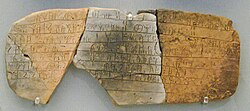Linear B
| Linear B | |
|---|---|
 | |
| Script type | with additional ideograms |
Time period | Late Bronze Age |
| Status | Extinct |
| Direction | left-to-right |
| Languages | Mycenaean Greek |
| Related scripts | |
Parent systems | Linear A
|
Sister systems | Cypro-Minoan syllabary |
| ISO 15924 | |
| ISO 15924 | Linb, 401 |
| Unicode | |
Unicode alias | Linear B |
Unicode range |
|
Linear B is a syllabic script that was used for writing Mycenaean Greek, the earliest attested form of Greek. The script predates the Greek alphabet by several centuries. The oldest Mycenaean writing dates to about 1450 BC.[1] It is descended from the older Linear A, an undeciphered earlier script used for writing the Minoan language, as is the later Cypriot syllabary, which also recorded Greek. Linear B, found mainly in the palace archives at Knossos, Cydonia,[2] Pylos, Thebes and Mycenae,[3] disappeared with the fall of Mycenaean civilization during the Late Bronze Age collapse. The succeeding period, known as the Greek Dark Ages, provides no evidence of the use of writing. It is also the only one of the Bronze Age Aegean scripts to have been deciphered, by English architect and self-taught linguist Michael Ventris.[4]
Linear B consists of around 87 syllabic signs and over 100 ideographic signs. These ideograms or "signifying" signs symbolize objects or commodities. They have no phonetic value and are never used as word signs in writing a sentence.
The application of Linear B appears to have been confined to administrative contexts. In all the thousands of clay tablets, a relatively small number of different "hands" have been detected: 45 in Pylos (west coast of the Peloponnese, in southern Greece) and 66 in Knossos (Crete).[5] It is possible that the script was used only by a guild of professional scribes who served the central palaces.[citation needed] Once the palaces were destroyed, the script disappeared.[6]
Script[]
Linear B has roughly 200 signs, divided into syllabic signs with phonetic values and ideograms with semantic values. The representations and naming of these signs have been standardized by a series of international colloquia starting with the first in Paris in 1956. After the third meeting in 1961 at the Wingspread Conference Center in Racine, Wisconsin, a standard proposed primarily by Emmett L. Bennett, Jr., became known as the Wingspread Convention, which was adopted by a new organization, the Comité International Permanent des Études Mycéniennes (CIPEM), affiliated in 1970 by the fifth colloquium with UNESCO. Colloquia continue: the 13th occurred in 2010 in Paris.[7]
Many of the signs are identical or similar to those in Linear A; however, Linear A encodes an as-yet unknown language, and it is uncertain whether similar signs had the same phonetic values.[8]
Syllabic signs[]
The grid developed during decipherment by Michael Ventris and John Chadwick of phonetic values for syllabic signs is shown below.[9] (Note that "q" represents the labialized velar stops [ɡʷ, kʷ, kʷʰ], not a uvular stop of IPA.)
Initial consonants are in the leftmost column; vowels are in the top row beneath the title. The transcription of the syllable, which may not have been pronounced that way, is listed next to the sign along with Bennett's identifying number for the sign preceded by an asterisk (as was Ventris' and Chadwick's convention).[note 1] If the transcription of the sign remains uncertain, Bennett's number serves to identify the sign.[10] The signs on the tablets and sealings often show considerable variation from each other and from the representations below. Discovery of the reasons for the variation and possible semantic differences is a topic of ongoing debate in Mycenaean studies.
| Recognised signs of shape V, CV[note 2] | ||||||||||
|---|---|---|---|---|---|---|---|---|---|---|
| -a | -e | -i | -o | -u | ||||||